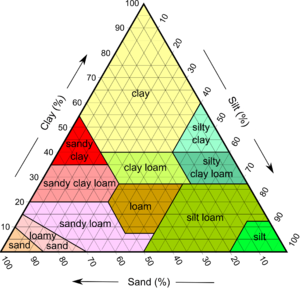Loam
Loam is a type of soil comprised of varying proportions of sand, silt, and clay.
Physical Properties
As seen in the figure to the right, the three types of soil can be combined in different amounts to form varying types of loam. The particle sizes range from large to small starting with sand, which is defined as having a particle size greater than 63 µm, silt, with a particle size greater than 2 µm, and clay, with particle sizes smaller than 2 µm. [1]
Life within the soil
Some of the inhabitants of loamy soil include the water-dependent protozoa and nematoda. They usually prefer soil containing more silt than sand due to its tendency to hold water. [2] Acari, also known as mites, can tolerate more desiccation than other microorganisms, so they do not need as much exposure to water and can live in a larger range of soil types.
Fertility of loamy soil
Gardening bois
References
[1] Kaufmann, Robert K.; Cutler J. Cleveland (2008). Environmental Science. McGraw-Hill. pp. 318–319. ISBN 978-0-07-298429-3. [2] Coleman, D. C., Crossley, D. A., Jr., & Hendrix, P. F. (2004). Fundamentals of Soil Ecology (2nd ed.). Amstherdan: Elsevier.
